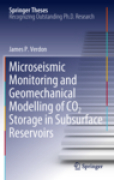
Microseismic monitoring and geomechanical modelling of CO2 storage in subsurface reservoirs
Verdon, James P.
This thesis presents an impressive summary of the potential to use passive seismic methods to monitor the sequestration of anthropogenic CO2 in geologic reservoirs. It brings together innovative research in two distinct areas - seismology and geomechanics - and involves both data analysis and numerical modelling. The data come from the Weyburn-Midale project, which is currently the largest Carbon Capture and Storage (CCS) project in the world. James Verdon’s results show how passive seismic monitoring can be used as an early warning systemfor fault reactivation and top seal failure, which may lead to the escape of CO2 at the surface. Nominated for a Springer Theses Prize by University of Bristol, UK. Using data from the Weyburn-Midale project, this thesis presents an impressive summary of the potential to use passive seismic methods to monitor the sequestration of anthropogenic CO2 in geologic reservoirs. The author received the 2010 Royal Astronomical Society Keith Runcorn Prize for best geophysics thesis in theUK INDICE: Introduction. The Weyburn CO2 injection project. Inverting shear-wave splitting measurements for fracture properties. A comparison of microseismic monitoring of fracture stimulation due to water versus CO2 injection. Geomechanical simulation of CO2 injection. Generating anisotropic seismic models based on geomechanical simulation. Forward modelling of seismic properties. Linking geomechanical modelling and microseismic observations at Weyburn. Conclusions. In Support of Carbon Capture and Storage.
- ISBN: 978-3-642-25387-4
- Editorial: Springer Berlin Heidelberg
- Encuadernacion: Cartoné
- Páginas: 183
- Fecha Publicación: 31/01/2012
- Nº Volúmenes: 1
- Idioma: Inglés
